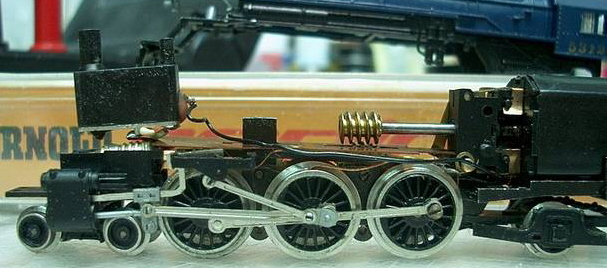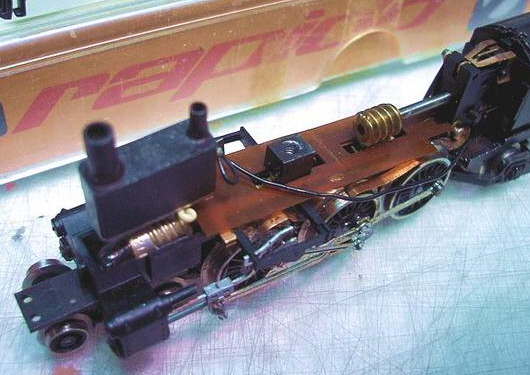



Introduced: 1967 (Pacific) and 1969 (Hudson)
Except for the trailing truck on the locomotive, these models are absolutely identical. The 4-6-2, despite a few prototypical inaccuracies, was a more or less reasonable representation of a USRA Pacific. On the other hand, the Hudson was apparently some kind of silly plot by Arnold to get two locomotives for the price of one. Obviously nothing that looked like this ever graced North American rails. Interestingly enough, the 4-6-2 was actually designed by one Ted Brandon, an American serviceman (and ardent model railroader) stationed in Germany at the time. Ted also provided the designs for Minitrix's 4-6-2 K4 steamer.
These models were initially imported into the US by Revell - a relationship that would last until around 1972. These were packaged in cardboard Revell boxes. Post-Revell, these models were imported primarily by Walthers (and probably others, but who really cares?) I've seen the older ones in cardboard boxes similar to the Revell packaging (sans the word "Revell"), and the newer ones packaged in the traditional Arnold plastic jewell box with the orange paper insert.
As far as I know, these models remained essentially the same throughout their entire production run (Arnold's philosophy apparently being "design it once and then run with it... forever"). That said, Arnold did completely redesign their German BR 01 Pacifics circa the early 90's (among other changes, the motor was relocated to the tender). However, since these USA-profile models never received that treatment, my assumption is that they were discontinued right around that time (if not earlier). They do seem to be quite rare and sought-after on eBay these days, so that would pretty much dovetail the notion that they've been out of production for quite a while.
These are decent looking models and very solid performers. The rear set of drivers is equipped with traction tires, so pickup is provided by the front four drivers (and with the pilot and trailing trucks being electrically neutral). Tender pickup is provided by four of the eight wheels (one rail per truck). Current is transferred from the tender to the motor via a pair of really flimsy wires that are seriously prone to coming unstuck if you're not careful. The locomotive shells are stuffed with weight, and the shells themselves are metal. Consequently, these things have some serious heft and can pull a ton. The motor is a "can", so I can't count the poles (but my assumption is three). The tender is equipped with a Rapido-style coupler (what a shock), whereas the pilot is inexplicably coupler-free. A non-directional headlight is mounted in the front of the chassis.
Performance is quite respectable, although not perfect by any means. They run relatively quietly for Arnolds (a notoriously noisy bunch), and the running gear action is quite smooth. The pick-up scheme is very good, so stalls and stuttering are not a problem. The flanges are notoriously "Arnold Deep", making for annoying Ka-Chunk sounds through turnouts. And although these models seem to be able to navigate very narrow radius (9.75") curves, they do occasionally look like they're getting ready to hop the rails while doing so. The main problem here is the motor. Slow speed performance just isn't there - these things start out fast. And as is generally the case with 3-pole motors, the top-end speed is best described as "meteoric". Nevertheless, considering the era in which they were produced, these are fine models that remain popular to this day (still commanding premium prices on eBay and elsewhere).
This is a pretty simple model and disassembly is a breeze. Unscrew the single ugly screw on top of the locomotive and the entire shell lifts off readily. The tender is held in place with four plastic clips, so gently prying each of them out with a small screwdriver will allow you remove the tender shell and reveal the rail contact wires soldered therein (a good place to start if you have one that is misbehaving).
Both of these models were available with optional smoke generators. However, since I've never actually owned a "smoker" myself, I can't really comment on how well they might operate.


(Thanks for the pictures, Tony)
Grade: B
Reviewed: 5/69 Model Railroader ("The original USRA heavy 4-6-2 was used only by the Erie RR... The Rapido ready-to-run model is a reasonably close reproduction of the prototype, although some liberties have been taken... The engine is about 3 scale feet too long, and the wheel sizes average about 4" undersize... The engine is well proportioned and readily identified as a USRA Pacific... The tender appears to be a model of the original USRA tender generally, but it is undersize in height and its lines are not the same... The trucks are not of USRA design, more closely resembling a variety used on the Reading... The superstructures are well detailed molded plastic... Handrails, hand grabs and piping are cast on... A 12-volt DC motor is mounted in the cab and drives a combination worm-and-gear/ spur-gear drive to all driving axles... This mechanically excellent system seems to eliminate all side-rod bind... The drivers are metal with flanges .033" deep... The rear drivers come equipped with friction treads to increase pull... Our sample suffered from the same malady that nearly all N-scale locomotives have- poor starting qualities... The model leaps to about scale 18 MPH, after which the performance is smooth and control is good... Price $29.98")